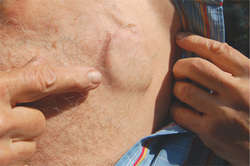
There are a lot of simple things that are good to know how to do when it comes to basic, everyday medical training. Schools have programs like BAT (Basic Aid Training) for things like this, but chances are you've gotten to do something as simple as: Take a 2-Step Radial Pulse.
Step 1: Find and grab the person's wrist with 3 fingers (your pointer, middle and ring fingers) on the spot below the thumb where the hand and the wrist meet (palm-side). Press down until you feel the pulse.
Step 2: Here's where you measure the strength, the rate and regularity. This is the harder part: Is the pulse easy to notice? Or is it very faint? Does it come in regular intervals or is there noticeable increases and decreases in speed? How many beats in 60 seconds? The normal rates should be between 60 and 100 for adults (ages roughly 11+), 70 to 120 for children ages 1-10, and 70 to 120 for children under 1 year old. In some circumstances, people who are in exceptional physical state will only beat 40 to 60 beats per minute (BPM).
To keep it simple for yourself, remember the adult numbers and work off of those: 60-100, children are a bit higher, fit people are a bit lower.
Step 1: Find and grab the person's wrist with 3 fingers (your pointer, middle and ring fingers) on the spot below the thumb where the hand and the wrist meet (palm-side). Press down until you feel the pulse.
Step 2: Here's where you measure the strength, the rate and regularity. This is the harder part: Is the pulse easy to notice? Or is it very faint? Does it come in regular intervals or is there noticeable increases and decreases in speed? How many beats in 60 seconds? The normal rates should be between 60 and 100 for adults (ages roughly 11+), 70 to 120 for children ages 1-10, and 70 to 120 for children under 1 year old. In some circumstances, people who are in exceptional physical state will only beat 40 to 60 beats per minute (BPM).
To keep it simple for yourself, remember the adult numbers and work off of those: 60-100, children are a bit higher, fit people are a bit lower.
 RSS Feed
RSS Feed